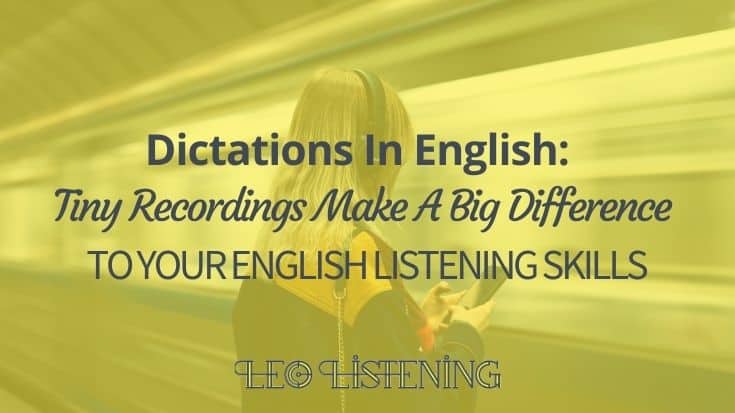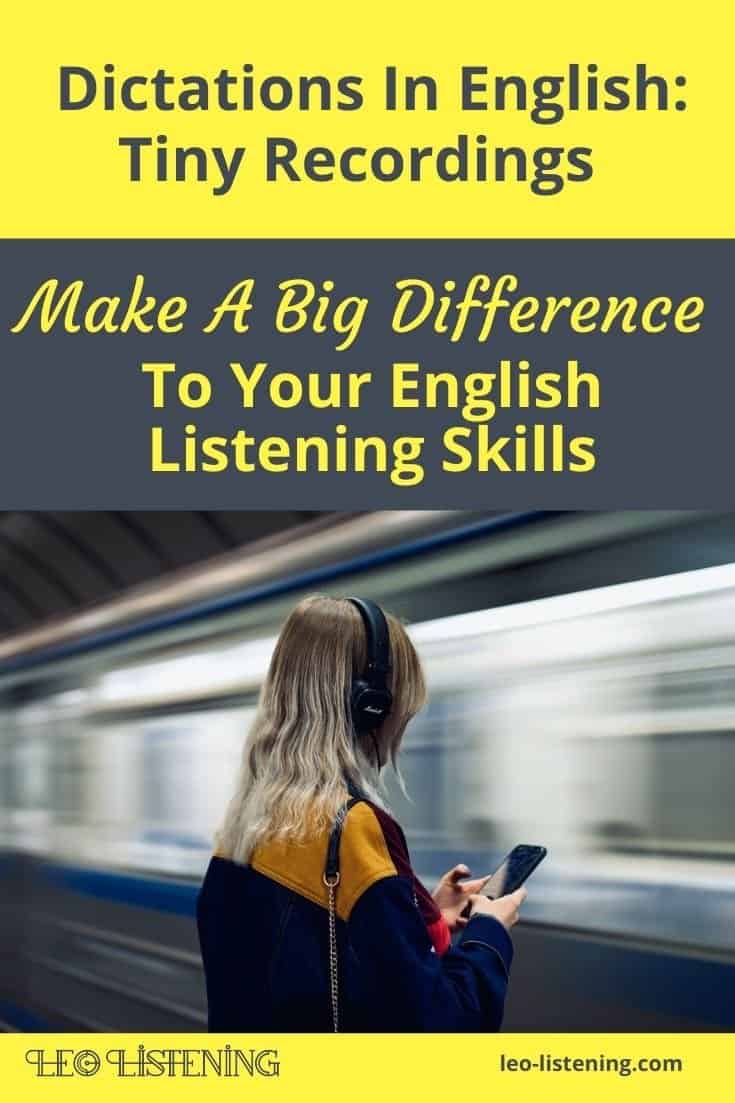Dictations In English: Tiny Recordings Make A Big Difference To Your Listening Skills

- But what if you were able to catch all the little details that you missed?
- What if you were able to stop guessing and start really understanding?
- And use what you hear to improve your English
Before I show you just how powerful dictations in English can be with an example from one of my online listening lessons, here are 3 dictation golden rules.
Dictations In English: Golden Rules
- use a short section – don’t try to write out 30 minutes of audio! It takes me 45 minutes to an hour to transcribe 5 minutes of my own voice and I’m a native speaker!
- make sure you have an accurate transcript of the recording to compare with your version. If you’re using a YouTube video transcript, make sure you see the closed captions symbol under the video. This means that the transcript was made by a real human. The YouTube automatic captions are full of errors.
- listen as many times as you need to. The idea is to catch everything, not to just get the gist. Of course, don’t spend hours on the task either. If there is one little word or section you just can’t understand, look at the transcript!

Dictation DIY: Do It Yourself
Dictation 1
Here’s the transcription of this section:
“I started reading the book and I must’ve read maybe half of it or something like that I was enjoying it so much.”
My learner caught the first 8 words no problem, but she really struggled with the contraction “must’ve read”.
Of course, she knows this grammatical structure, but she found it hard to notice in speech, maybe because she expected to hear “must have”, without a contraction.
In the next section, she interpreted “maybe half of it” as “maybe half an hour”, which I think is a good interpretation given the context. I’m talking about reading a book and perhaps I read it for 30 minutes.
Ultimately though, she didn’t understand the way I pronounced the preposition ‘it’. In the final section, she didn’t hear the word ‘it’ either and wrote “I was enjoying so much”.
As an English learner, you know the word ‘it’, but you might not realise the different ways we say this word in fast speech.
It is really common for speakers to swallow the ’t’ (like in my case) or make it disappear completely when the next sound is a consonant. We would be more likely to pronounce the ’t’ sound is when the following sound is a vowel: “it isn’t” for example.
Dictation 2
Here’s the transcription of dictation number 2:
“um in fact I got back on Friday erm I was really tired on Friday night but I started reading the book errrmmm when I went to bed actually”
My learner heard “go” not “got” and found it hard to catch the last 4 words. As I mentioned above, the ’t’ sound is not always pronounced at the ends of words. We often replace the ’t’ by a sound called a glottal stop, which is a sound we make by closing our throats.
The last four words of this extract are particularly difficult to hear because:
- – the ’t’ in ‘went’ disappears because the next word starts with a ’t’. It sounds like ‘wen’
- – I don’t pronounce the vowel in ‘to’, only the consonant sound ’t’
- – the final ‘d’ sound in bed connects to the first sound in ‘actually’ so it sounds like one word, not two
- – the word ‘actually’ gets very squashed! I pronounce it using two syllables, not three and it sounds like ‘akshlee’.
Here’s a final audio extract for you to try transcribing. Try counting how many words you hear first and then try to write what you hear. After, compare with the transcription underneath the audio.
Dictation 3
Here’s the transcription of dictation 3:
“Erm and I just wanted you to erm you know talk to you a little bit about some of my impressions of the book and what I liked about it”
So.
- How did you do?
- How much of it did you transcribe correctly?
- Which parts did you mishear?
By the way, if you’re wondering which book I’m talking about, it’s “The Girl on the Train” by Paula Hawkins. To hear me talk more about this book, listen to the podcast episode below.
Dictations In English: Time To Start Doing Them
As you can see (or hear rather!), using tiny sections of audio to do dictations in English can make a big difference to your listening skills.
Dictations in English can:
- help you identify the words you find difficult to understand and make you think about why that is.
- help you understand the difference between the written form of a word and its spoken form(s).
- make you realise that some very common words can be pronounced in ways you don’t expect in speech.
I hope you’re going to start using dictations to develop your English listening skills!